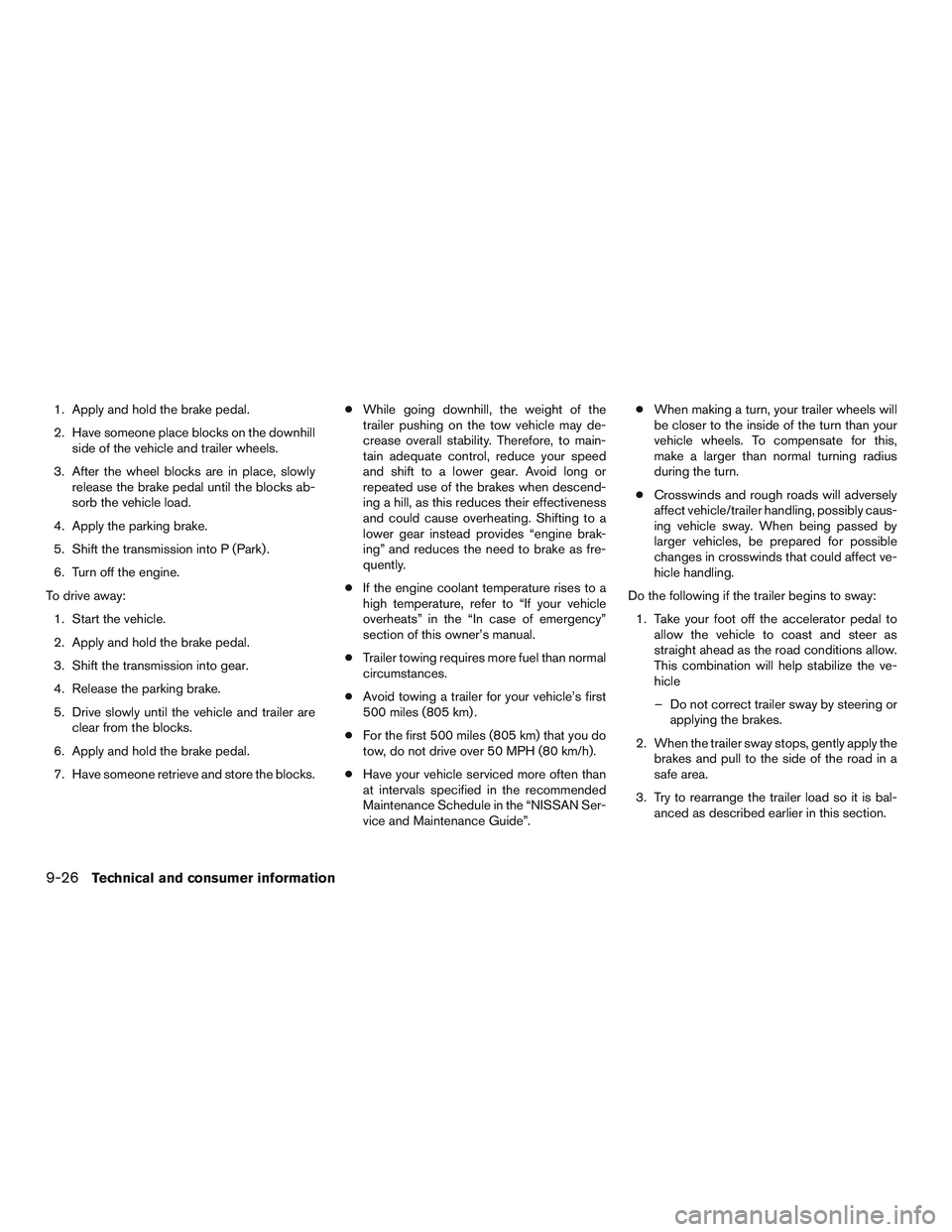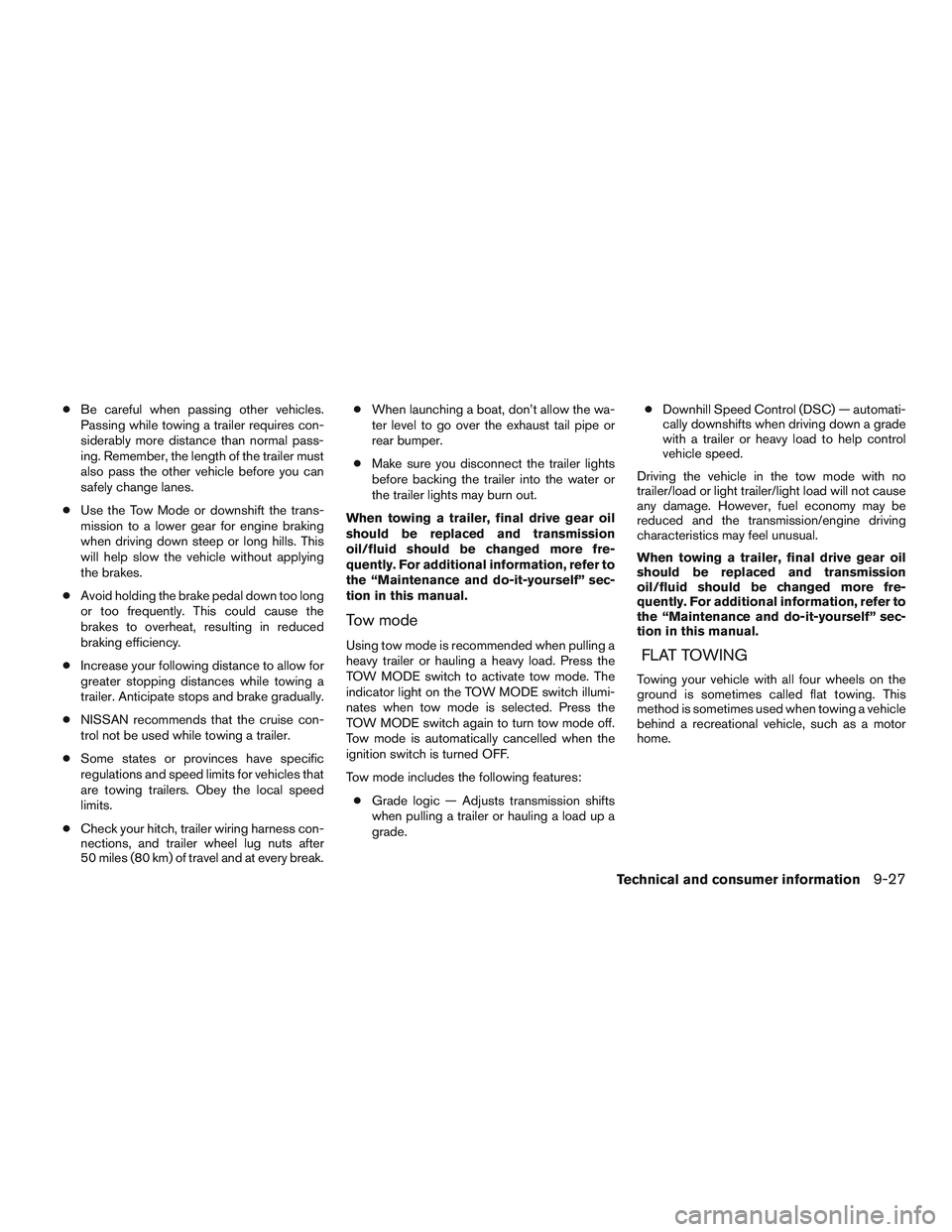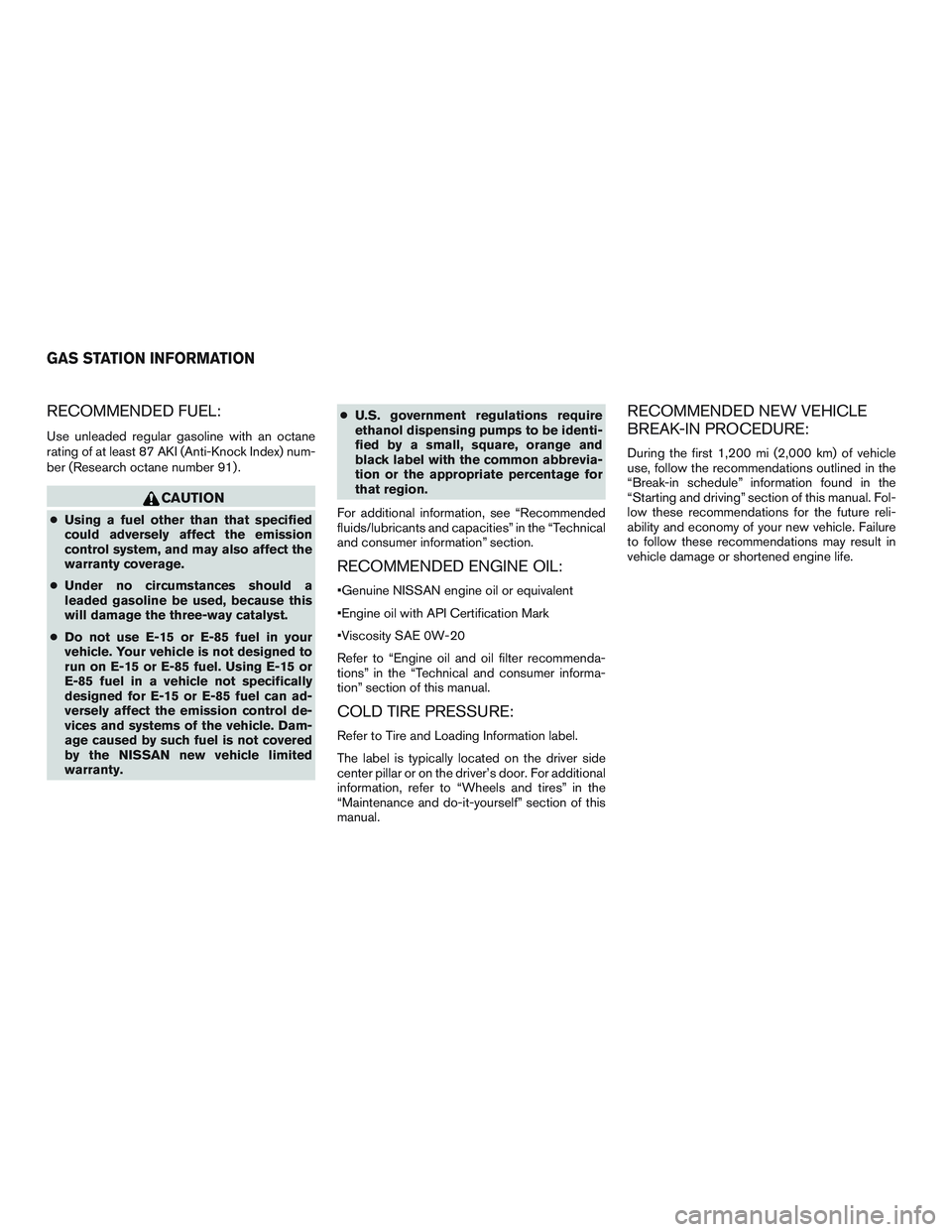2015 NISSAN PATHFINDER HYBRID maintenance
[x] Cancel search: maintenancePage 509 of 524

1. Apply and hold the brake pedal.
2. Have someone place blocks on the downhill
side of the vehicle and trailer wheels.
3. After the wheel blocks are in place, slowly
release the brake pedal until the blocks ab-
sorb the vehicle load.
4. Apply the parking brake.
5. Shift the transmission into P (Park) .
6. Turn off the engine.
To drive away:
1. Start the vehicle.
2. Apply and hold the brake pedal.
3. Shift the transmission into gear.
4. Release the parking brake.
5. Drive slowly until the vehicle and trailer are
clear from the blocks.
6. Apply and hold the brake pedal.
7. Have someone retrieve and store the blocks.●While going downhill, the weight of the
trailer pushing on the tow vehicle may de-
crease overall stability. Therefore, to main-
tain adequate control, reduce your speed
and shift to a lower gear. Avoid long or
repeated use of the brakes when descend-
ing a hill, as this reduces their effectiveness
and could cause overheating. Shifting to a
lower gear instead provides “engine brak-
ing” and reduces the need to brake as fre-
quently.
●If the engine coolant temperature rises to a
high temperature, refer to “If your vehicle
overheats” in the “In case of emergency”
section of this owner’s manual.
●Trailer towing requires more fuel than normal
circumstances.
●Avoid towing a trailer for your vehicle’s first
500 miles (805 km) .
●For the first 500 miles (805 km) that you do
tow, do not drive over 50 MPH (80 km/h).
●Have your vehicle serviced more often than
at intervals specified in the recommended
Maintenance Schedule in the “NISSAN Ser-
vice and Maintenance Guide”.●When making a turn, your trailer wheels will
be closer to the inside of the turn than your
vehicle wheels. To compensate for this,
make a larger than normal turning radius
during the turn.
●Crosswinds and rough roads will adversely
affect vehicle/trailer handling, possibly caus-
ing vehicle sway. When being passed by
larger vehicles, be prepared for possible
changes in crosswinds that could affect ve-
hicle handling.
Do the following if the trailer begins to sway:
1. Take your foot off the accelerator pedal to
allow the vehicle to coast and steer as
straight ahead as the road conditions allow.
This combination will help stabilize the ve-
hicle
– Do not correct trailer sway by steering or
applying the brakes.
2. When the trailer sway stops, gently apply the
brakes and pull to the side of the road in a
safe area.
3. Try to rearrange the trailer load so it is bal-
anced as described earlier in this section.
9-26Technical and consumer information
Page 510 of 524

●Be careful when passing other vehicles.
Passing while towing a trailer requires con-
siderably more distance than normal pass-
ing. Remember, the length of the trailer must
also pass the other vehicle before you can
safely change lanes.
●Use the Tow Mode or downshift the trans-
mission to a lower gear for engine braking
when driving down steep or long hills. This
will help slow the vehicle without applying
the brakes.
●Avoid holding the brake pedal down too long
or too frequently. This could cause the
brakes to overheat, resulting in reduced
braking efficiency.
●Increase your following distance to allow for
greater stopping distances while towing a
trailer. Anticipate stops and brake gradually.
●NISSAN recommends that the cruise con-
trol not be used while towing a trailer.
●Some states or provinces have specific
regulations and speed limits for vehicles that
are towing trailers. Obey the local speed
limits.
●Check your hitch, trailer wiring harness con-
nections, and trailer wheel lug nuts after
50 miles (80 km) of travel and at every break.●When launching a boat, don’t allow the wa-
ter level to go over the exhaust tail pipe or
rear bumper.
●Make sure you disconnect the trailer lights
before backing the trailer into the water or
the trailer lights may burn out.
When towing a trailer, final drive gear oil
should be replaced and transmission
oil/fluid should be changed more fre-
quently. For additional information, refer to
the “Maintenance and do-it-yourself” sec-
tion in this manual.
Tow mode
Using tow mode is recommended when pulling a
heavy trailer or hauling a heavy load. Press the
TOW MODE switch to activate tow mode. The
indicator light on the TOW MODE switch illumi-
nates when tow mode is selected. Press the
TOW MODE switch again to turn tow mode off.
Tow mode is automatically cancelled when the
ignition switch is turned OFF.
Tow mode includes the following features:
●Grade logic — Adjusts transmission shifts
when pulling a trailer or hauling a load up a
grade.●Downhill Speed Control (DSC) — automati-
cally downshifts when driving down a grade
with a trailer or heavy load to help control
vehicle speed.
Driving the vehicle in the tow mode with no
trailer/load or light trailer/light load will not cause
any damage. However, fuel economy may be
reduced and the transmission/engine driving
characteristics may feel unusual.
When towing a trailer, final drive gear oil
should be replaced and transmission
oil/fluid should be changed more fre-
quently. For additional information, refer to
the “Maintenance and do-it-yourself” sec-
tion in this manual.FLAT TOWING
Towing your vehicle with all four wheels on the
ground is sometimes called flat towing. This
method is sometimes used when towing a vehicle
behind a recreational vehicle, such as a motor
home.
Technical and consumer information9-27
Page 513 of 524

https://wwwapps.tc.gc.ca/Saf-Sec-Sur/
7/PCDB-BDPP/fc-cp.aspx?lang=fra
(French speakers)
Additional information concerning motor
vehicle safety may be obtained from Trans-
port Canada’s Road Safety Information
Centre at 1-800-333-0371 or online at
www.tc.gc.ca/roadsafety (English speak-
ers) or www.tc.gc.ca/securiteroutiere
(French speakers) .
To notify NISSAN of any safety concerns
please contact our Consumer Information
Centre toll free at 1-800-387-0122.
WARNING
A vehicle equipped with Four-Wheel Drive
(4WD) should never be tested using a two
wheel dynamometer (such as the dyna-
mometers used by some states for emis-
sions testing) , or similar equipment. Make
sure you inform the test facility personnel
that your vehicle is equipped with 4WD
before it is placed on a dynamometer.
Using the wrong test equipment may re-
sult in transmission damage or unex-
pected vehicle movement which could re-
sult in serious vehicle damage or personal
injury.
Due to legal requirements in some states and
Canadian Provinces, your vehicle may be re-
quired to be in what is called the “ready condi-
tion” for an Inspection/Maintenance (I/M) test of
the emission control system.
The vehicle is set to the “ready condition” when it
is driven through certain driving patterns. Usually,
the ready condition can be obtained by ordinary
usage of the vehicle.If a powertrain system component is repaired or
the battery is disconnected, the vehicle may be
reset to a “not ready” condition. Before taking the
I/M test, check the vehicle’s
inspection/maintenance test readiness condi-
tion. Place the ignition switch in the ON position
without starting the engine. If the Malfunction
Indicator Light (MIL) comes on steady for 20 sec-
onds and then blinks for 10 seconds , the I/M test
condition is “not ready”. If the MIL does not blink
after 20 seconds, the I/M test condition is
“ready”. Contact a NISSAN dealer to set the
“ready condition” or to prepare the vehicle for
testing.
READINESS FOR INSPECTION/
MAINTENANCE (I/M) TEST
9-30Technical and consumer information
Page 518 of 524

Front air bag system
(See supplemental restraint system)......1-54
Front power seat adjustment...........1-4
Frontseats.....................1-2
Fuel
Capacities and recommended
fuel/lubricants.................9-2
Fuel economy................5-35
Fuel-filler door and cap...........3-28
Fuel gauge...................2-5
Fuel octane rating...............9-5
Loose fuel cap warning........2-30,3-29
Fuel gauge.....................2-5
Fuses.......................8-22
Fusible links...................8-22
G
Garage door opener, HomeLink® Universal
Transceiver....................2-63
Gascap .....................3-28
Gauge
Fuel gauge...................2-5
Odometer...................2-4
Power meter..................2-6
Speedometer.................2-4
Tachometer..................2-5
Trip odometer.................2-4
General maintenance...............8-2
Glovebox.....................2-49
Gloveboxlock..................2-49H
Hands-free phone system,
Bluetooth®...............4-109, 4-124
Hazard warning flasher switch..........6-2
Headlight and turn signal switch........2-36
Headlight control switch............2-37
Headlights....................8-26
Head restraints..................1-11
Heated seats............2-41,2-42,2-43
Heated steering wheel.............2-44
Heater
Heater and air conditioner controls.....4-43
Heater operation...............4-44
High voltage components..........HEV-10
Hill descent control system...........5-45
Hill start assist system..............5-46
HomeLink® Universal Transceiver.......2-63
Hood release...................3-22
Hook
Luggage hook................2-53
Horn .......................2-41
Hybrid System
Stops operating while driving.........6-9
Vehicle does not start............6-10
Hybrid vehicle characteristics........HEV-12
I
Ignition Switch
Push-Button Ignition Switch........5-10
Imageviewer...................4-19
Immobilizer system.........2-32,3-4,5-13
Important vehicle information label.......9-11In-cabin microfilter................8-19
Increasing fuel economy.............5-35
Indicator lights and audible reminders
(See warning/indicator lights and audible
reminders).....................2-9
Inside automatic anti-glare mirror........3-33
Instrument brightness control..........2-39
Instrumentpanel...............0-6,2-2
Instrument panel dimmer switch........2-39
Intelligent Key system
Key operating range..............3-9
Key operation................3-10
Mechanical key................3-3
Remote keyless entry operation.......3-14
Troubleshooting guide............3-18
Warning signals...............3-18
Interior light....................2-61
Inverter
Checking inverter coolant level.......8-10
Inverter cooling system............8-9
iPod®Player ...............4-84, 4-86
ISOFIX child restraints.............1-27
J
Jump starting...................6-11
K
Key fob battery replacement..........8-24
Keyless entry
With Intelligent Key system
(See Intelligent Key system).........3-14
Keys, For Intelligent Key system.......3-2,3-7
10-3
Page 519 of 524

L
Labels
Air conditioner specification label.....9-12
C.M.V.S.S. certification label........9-11
Emissioncontrolinformationlabel.....9-11
Engine serial number............9-11
F.M.V.S.S. certification label.........9-11
Tire and Loading Information label.....9-12
Vehicle identification number (VIN) plate . .9-10
Warning labels (for SRS)..........1-64
LATCH (Lower Anchors and Tethers for CHildren)
System......................1-27
Liftgate......................3-23
Liftgaterelease.................3-27
Light
Airbagwarninglight.........1-65,2-15
Brake light (See stop light).........8-27
Bulb check/instrument panel........2-10
Bulb replacement..............8-27
Charge warning light............2-11
Foglightswitch ...............2-40
Headlight and turn signal switch......2-36
Headlight control switch..........2-37
Headlights..................8-26
Interiorlight..................2-61
Lightbulbs..................8-26
Low tire pressure warning light.......2-12
Low windshield-washer fluid warning
light ..................2-14,2-29
Passenger air bag and status light.....1-56
Security indicator light............2-17
Spotlights(Seemaplight) .........2-62
Warning/indicator lights and audible
reminders...................2-9Lights
Maplights ..................2-62
Lock
Child safety rear door lock..........3-7
Door locks...................3-5
Gloveboxlock................2-49
Liftgaterelease...............3-27
Power door locks...............3-6
Loose fuel cap warning..........2-30,3-29
Lowfuelwarninglight.......2-12,2-14,2-28
Low tire pressure warning light.........2-12
Low windshield-washer fluid warning
light ....................2-14,2-29
Luggage hook..................2-53
Luggage rack (see roof rack)..........2-54
Luggage (See vehicle loading information) . .9-13
Luggage storage
(see vehicle loading information)........2-54
M
Maintenance
Generalmaintenance.............8-2
Insidethevehicle...............8-3
Maintenance precautions...........8-5
Outside the vehicle..............8-2
Seatbeltmaintenance............1-23
Underthehoodandvehicle .........8-4
Malfunction indicator light............2-16
Manual front seat adjustment...........1-2
Maplights ....................2-62
Map pocket....................2-48
Memory Seat...................3-36
Meters and gauges................2-3
Instrument brightness control........2-39Mirror
Automatic anti-glare inside mirror......3-33
Outside mirror control............3-35
Outside mirrors...............3-35
Vanity mirror.................3-33
Moonroof.....................2-57
N
NISSAN vehicle immobilizer
system................2-32,3-4,5-13
NISSAN voice recognition system......4-137
O
Octane rating (See fuel octane rating)......9-5
Odometer.....................2-4
Oil
Capacities and recommended
fuel/lubricants.................9-2
Changingengineoil.............8-11
Changing engine oil filter..........8-13
Checking engine oil level..........8-10
Engineoil...................8-10
Engine oil and oil filter recommendation . . .9-6
Engine oil viscosity..............9-6
Oneshotcall..................4-113
Outside mirror control..............3-35
Outside mirrors.................3-35
Owner’s manual order form...........9-31
Owner’s manual/service manual order
information....................9-31
10-4
Page 520 of 524

P
Parking
Parking brake operation...........5-18
Parking/parking on hills...........5-39
Phone, Bluetooth® hands-free
system.................4-109, 4-124
Power
Front seat adjustment.............1-4
Power door locks...............3-6
Power outlet..............2-46,2-48
Power rear windows.............2-56
Power steering fluid.............8-14
Power steering system...........5-40
Power windows...............2-55
Rear power windows............2-56
Power inverter switch..............2-45
Power meter....................2-6
Power outlet................2-46,2-48
Power steering..................5-40
Power steering fluid...............8-14
Precautions
Maintenance precautions...........8-5
On-pavement and off-road driving
precautions ..................5-6
Precautions on booster
seats...........1-25,1-32,1-39,1-44
Precautions on child
restraints.........1-25,1-32,1-39,1-44
Precautionsonseatbeltusage.......1-16
Precautions on supplemental restraint
system ....................1-47
Precautions when starting and driving....5-2
Pre-tensioner seat belt system.........1-63
Push starting...................6-13R
Radio
Car phone or CB radio...........4-108
FM/AM/SAT radio with CD/DVD player . .4-70
FM/AM/SAT radio with compact disc (CD)
player.....................4-63
Steering wheel audio control switch....4-94
Readiness for inspection maintenance
(I/M) test.....................9-30
Rear power windows..............2-56
Rear sonar system................5-47
RearView Monitor................4-21
Rear window and outside mirror defroster
switch.......................2-36
Rear window wiper and washer switches . . .2-35
Recorders
Eventdata..................9-31
Refrigerant recommendation...........9-7
Registering your vehicle in another country . .9-10
Remote Start...............3-20,5-14
Reporting safety defects (US only).......9-29
Roof rack.....................2-54
S
Safety
Child safety rear door lock..........3-7
Child seat belts.....1-25,1-32,1-39,1-44
Reporting safety defects (US only).....9-29
Seat adjustment
Frontmanualseatadjustment ........1-2
Front power seat adjustment.........1-4
Second row bench seats........1-6,1-8Seatbackpockets................2-49
Seat belt
Child safety..................1-23
Infants and small children..........1-24
Injured Person................1-19
Largerchildren................1-24
Precautions on seat belt usage.......1-16
Pregnant women...............1-19
Pre-tensioner seat belt system.......1-63
Seatbeltextenders .............1-22
Seatbeltmaintenance............1-23
Seatbelts...................1-16
Shoulder belt height adjustment......1-22
Three-point type with retractor.......1-19
Seat belt extenders...............1-22
Seatbeltwarninglight..........1-19,2-14
Seats
2nd row bench seat adjustment....1-6,1-8
Adjustment...................1-2
Armrests....................1-9
Automatic drive positioner..........3-36
Frontseats...................1-2
Heatedseats..........2-41, 2-42, 2-43
Manualfrontseatadjustment.........1-2
Security indicator light..............2-17
Security system (NISSAN vehicle immobilizer
system) , engine start........2-32,3-4,5-13
Security systems
Vehicle security system...........2-31
Self-adjusting brakes..............8-21
Service manual order form...........9-31
Servicing air conditioner.............4-47
Shoulder belt height adjustment........1-22
Sonar
Rear system.................5-47
Sparkplugreplacement.............8-18
10-5
Page 523 of 524

RECOMMENDED FUEL:
Use unleaded regular gasoline with an octane
rating of at least 87 AKI (Anti-Knock Index) num-
ber (Research octane number 91) .
CAUTION
●Using a fuel other than that specified
could adversely affect the emission
control system, and may also affect the
warranty coverage.
●Under no circumstances should a
leaded gasoline be used, because this
will damage the three-way catalyst.
●Do not use E-15 or E-85 fuel in your
vehicle. Your vehicle is not designed to
run on E-15 or E-85 fuel. Using E-15 or
E-85 fuel in a vehicle not specifically
designed for E-15 or E-85 fuel can ad-
versely affect the emission control de-
vices and systems of the vehicle. Dam-
age caused by such fuel is not covered
by the NISSAN new vehicle limited
warranty.●U.S. government regulations require
ethanol dispensing pumps to be identi-
fied by a small, square, orange and
black label with the common abbrevia-
tion or the appropriate percentage for
that region.
For additional information, see “Recommended
fluids/lubricants and capacities” in the “Technical
and consumer information” section.
RECOMMENDED ENGINE OIL:
•Genuine NISSAN engine oil or equivalent
•Engine oil with API Certification Mark
•Viscosity SAE 0W-20
Refer to “Engine oil and oil filter recommenda-
tions” in the “Technical and consumer informa-
tion” section of this manual.
COLD TIRE PRESSURE:
Refer to Tire and Loading Information label.
The label is typically located on the driver side
center pillar or on the driver’s door. For additional
information, refer to “Wheels and tires” in the
“Maintenance and do-it-yourself” section of this
manual.
RECOMMENDED NEW VEHICLE
BREAK-IN PROCEDURE:
During the first 1,200 mi (2,000 km) of vehicle
use, follow the recommendations outlined in the
“Break-in schedule” information found in the
“Starting and driving” section of this manual. Fol-
low these recommendations for the future reli-
ability and economy of your new vehicle. Failure
to follow these recommendations may result in
vehicle damage or shortened engine life.
GAS STATION INFORMATION